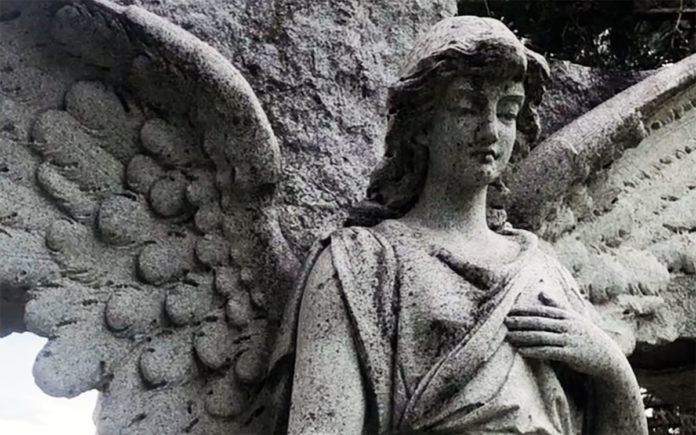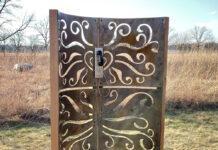Calvary Cemetery in Mankato celebrates legacies, from the early townspeople buried there to the man who, for the last 47 years, has tended to the luxurious grounds, beginning as a 12-year-old at the side of his father.
Terry Miller has a wonderful working history of the 40-acre cemetery, which was still on the edge of town when it was purchased in 1885 from the estate of Thomas Rieger for just $2,020. Today, it is surrounded by residential areas and is a popular spot for walking or running. It’s also, in a way, invisible to the town it serves.
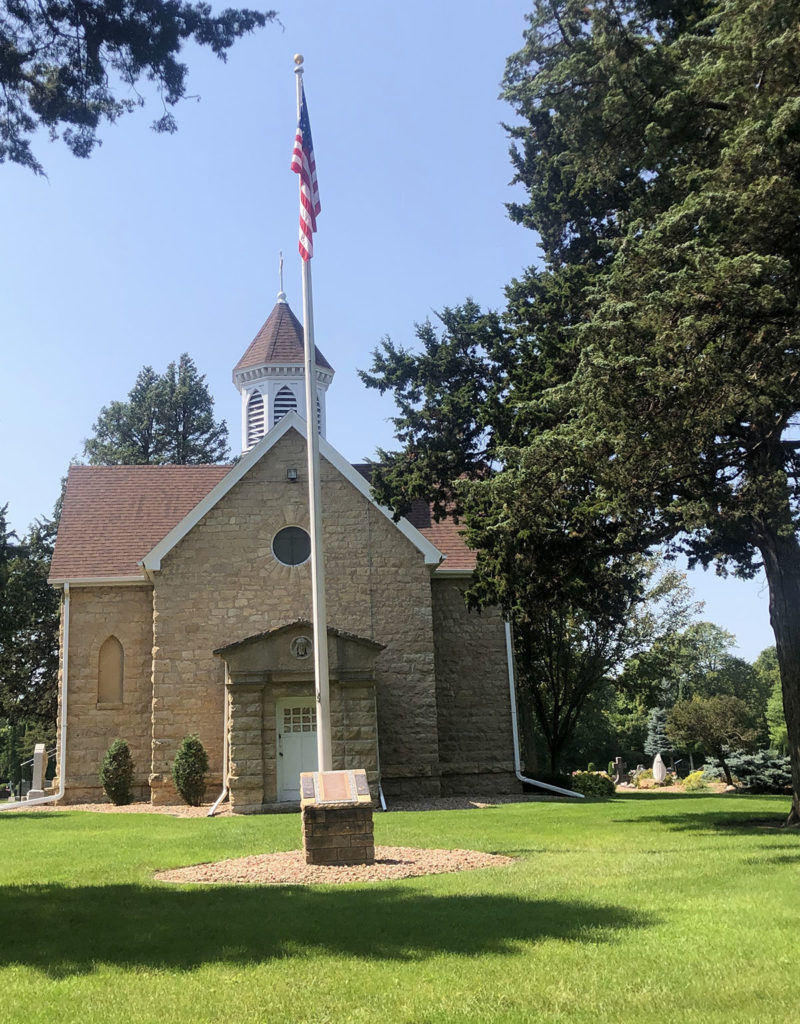
A long history
Calvary succeeded an earlier cemetery along North Sixth Street. Its first funeral took place on Nov. 5, 1886, when Frank Salfer was laid to rest. Originally a Catholic cemetery serving the four parishes of Saint Peter and Paul’s Catholic Church, St. John the Baptist, St. Joseph the Worker and Holy Rosary, the cemetery now accepts any Christian seeking burial.
“People ask this question,” Miller said. “‘How many years before you’re full?’ Well, my educated guess — and I feel I’m educated — is probably 150 years, at least.”
The reason, he said, is that more people choose cremation today, which requires nearly 60 percent less space.
People ask this question: ‘How many years before you’re full?’ Well, my educated guess — and I feel I’m educated — is probably 150 years, at least.Terry Miller
The cemetery contains red cedar trees, which eliminates the need for fall leaf removal and keeps it green throughout the year.
“When it snows and you come in here, it’s gorgeous because it’s still green,” Miller said. “I can’t sit here and take credit. I just have to give credit to the people before me.”
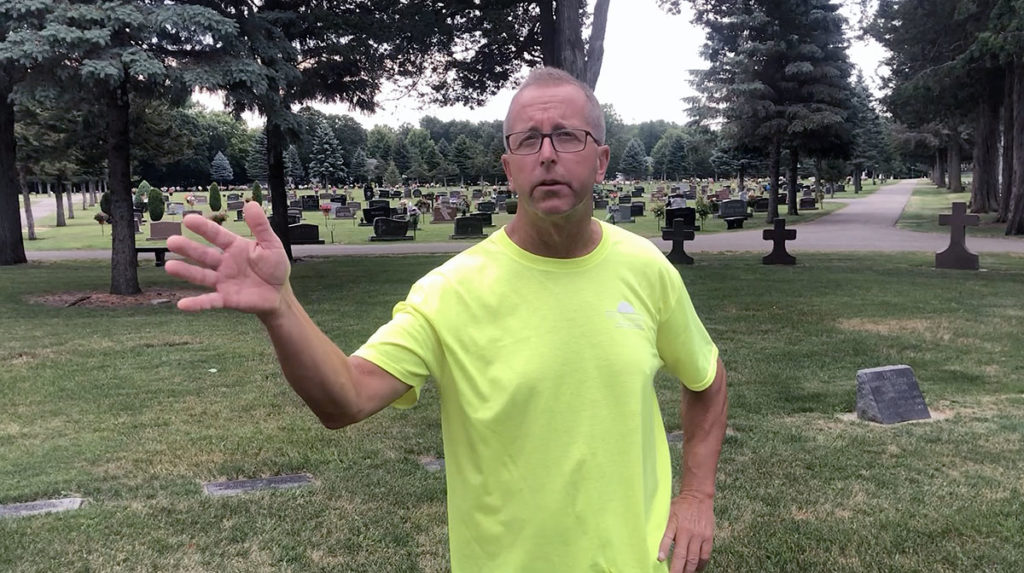
A beautiful chapel
The cemetery is laid out on a grid of streets that includes many saints’ names: St. Francis, St. Jerome, St. Peter and St. Paul, and St. John, among others. There’s also a Veterans Drive, a Calvary Drive and, highlighting the distinctive 1895 limestone chapel, a Chapel Drive.
The contract for the construction of the chapel was awarded to Joseph Kotthoff, grandfather of a current SS. Peter & Paul’s parishioner, on June 19, 1894. The chapel is small, only seating about 90 people, but it houses small services and their annual Memorial Day and All Souls Day masses. It was blessed by the Rev. Bishop Cotter of the Diocese of Winona on All Souls Day, 1895.
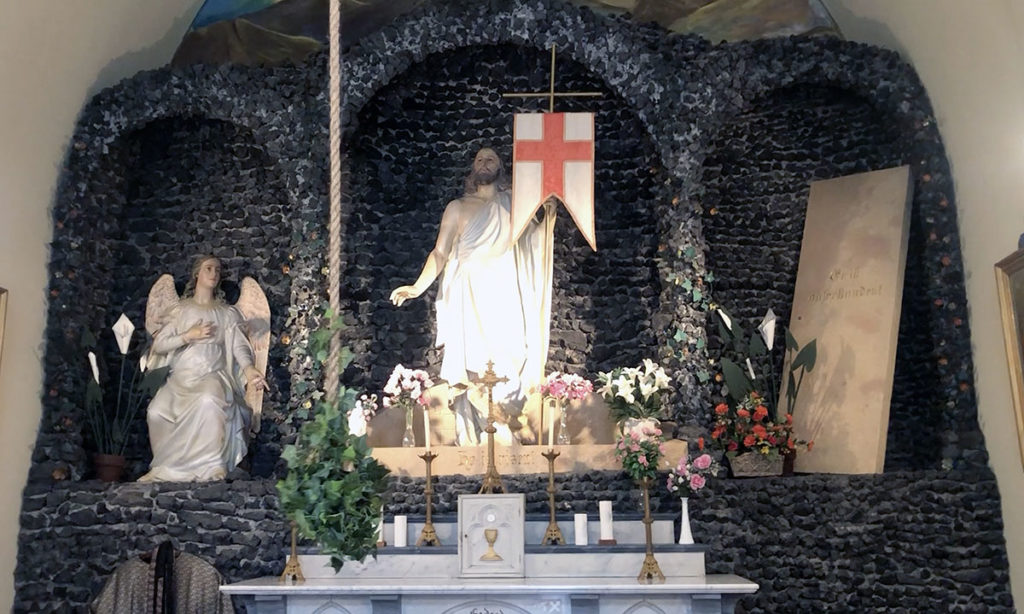
The Stations of the Cross inside the chapel came from SS. Peter & Paul’s Catholic Church in the 1930s, Miller suspects, and were restored in 1994 by Mankato artist Sue Mueller. The marble altar was carved by Joseph Masberg of Mankato, a gift from Friedrich Kron. The two angels on the wall above the altar were blessed April 19, 1896. One represents the risen Savior, and the other the angel who announced the Resurrection. One angel directs the eye to the stone which he has rolled back from the tomb and has the inscription: “He Has Risen.”
We’ve got the symbol of the dove in the high window up there, and right below it on the arch coming in the doors you can see all the churches of the town, the parishes we serve.Terry Miller
Stained glass windows were provided by Charlie Thompson in honor of his son, Jacob, who is buried on the east side of the chapel.
“If you look here, we’ve got the symbol of the dove in the high window up there, and right below it on the arch coming in the doors you can see all the churches of the town, the parishes we serve,” Miller said.
On the east wall is a window that includes a Purple Heart.
“We can’t forget about the bell,” Miller added. “This bell started on the West Coast; it was on its way to the East Coast and sunk in the bottom of the Mississippi River, and it was retrieved and brought to St. Clair, Minnesota.”
When the St. Clair church closed, the bell was moved to SS. Peter & Paul’s Church until a bigger church was built.
Different kinds of resting places
The basement of the chapel has a concrete floor that replaced a dirt floor. The furnace and sump pump make the chapel more functional. The main original feature is a wall of crypts that once held the bodies of priests from the Society of Jesus, Miller said. These priests were removed and buried in the front yard, though the crypts remain. They are buried opposite the Sisters of the Sorrowful Mother, who at one time served in the former St. Joseph Hospital on North Fifth Street. They later served at the new St. Joseph Hospital on the hilltop.
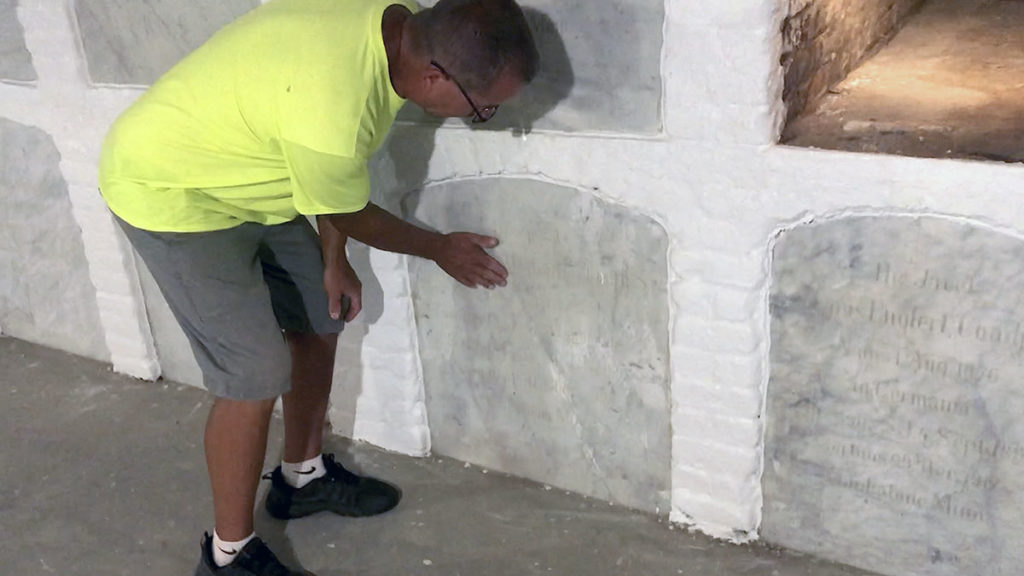
Several stones were damaged and repaired by Miller’s brother, Tom Miller; one crypt face was removed and the crypt lighted.
“A good priest can probably tell you what some of this means,” Miller said, pointing at the crypt faces. “It’s a lot of German: their birthdate, when they’re ordained, their death date. And if you notice ‘Mankatone’… There’s just a lot of theories behind all of this writing.”
A good priest can probably tell you what some of this means. It’s a lot of German: their birthdate, when they’re ordained, their death date.There’s just a lot of theories behind all of this writing.Terry Miller
According to the history of the cemetery on its blog, “Calvary Cemetery,” there is an angel grave market near the sidewalk and roadway in front of the chapel. “This marks the grave of Sister Mary Joseph Crehan who, along with Father Martin McDonnell, established Sacred Heart Orphanage in Mankato in 1908,” the blog states. The orphanage was located overlooking the slough in West Mankato, and housed as many as 15 children at a time. Sister Joseph died in 1914 after a brief illness. Her pallbearers were four boys who had been raised at the orphanage. The facility was closed shortly after her death.
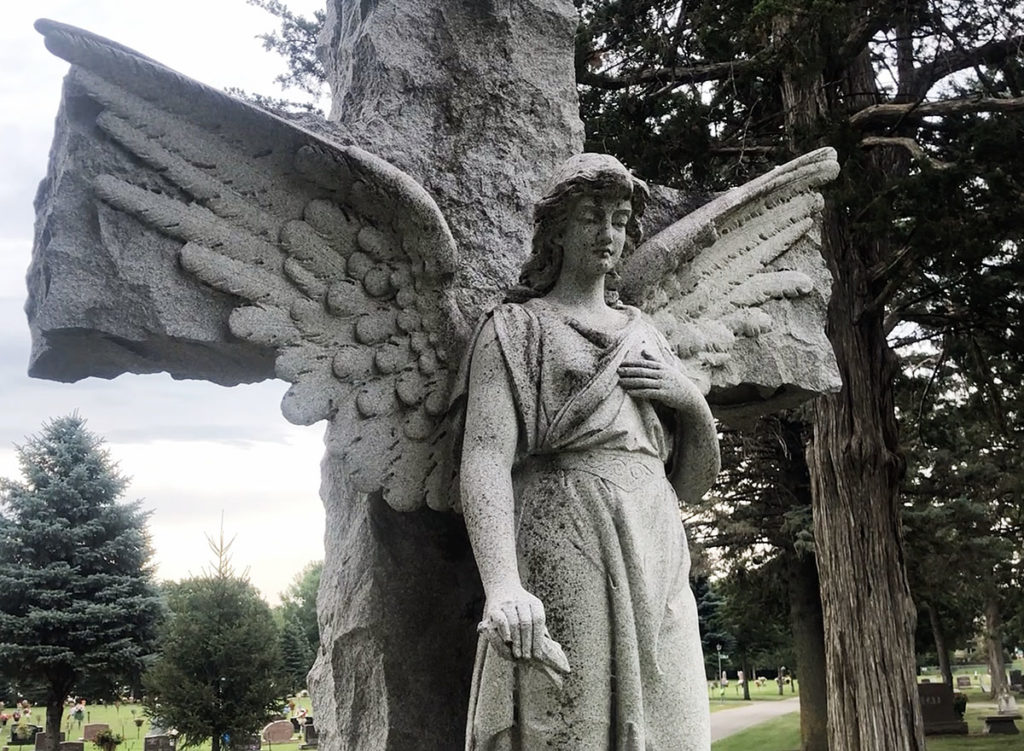
Names on headstones in the cemetery represent many of Mankato’s early business people: Thro, Hiniker, etc. But one stone draws the most attention.
“This Kron monument, this is the most photographed monument in the cemetery,” Miller said, pointing to the large stone angel honoring the burial place of businessman Fred Kron. “It was actually carved in Belgium and brought over on a boat, pulled up the hill here with horses. [It’s] very detailed, all the way down to the fingernails and everything.”
The building is two feet thick, [and] it’s all marble inside. To give you an idea, I believe the cost on it was $11,000, which was a lot of money. To build that same thing today, it might be $220,000.Terry Miller
The cemetery has just one mausoleum, built for Dr. Peter Pollman in the 1940s.
“The building is two feet thick, [and] it’s all marble inside,” Miller said. “To give you an idea, I believe the cost on it was $11,000, which was a lot of money. To build that same thing today, it might be $220,000.”
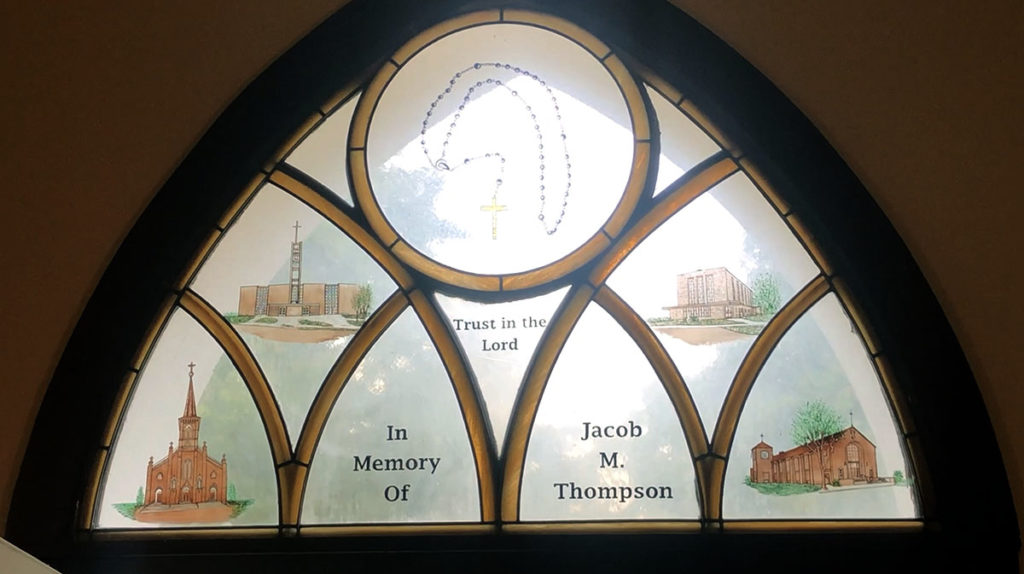
A father-son business
According to Miller, his father, Jerome “Jerry” Miller, wasn’t a man of many words—but he still taught his son how to carry on the family profession.
“Yeah, he wasn’t much of a teacher,” he said with a chuckle. “I just had to watch. Obviously, just growing up [from 12 years old] and watching the ins and outs and how he did things, I picked it up. All the way from learning how to drive my first stick shift to digging a grave to exhuming a body and moving it elsewhere. He taught me everything indirectly, in his own way. He was a character.”
~~~
ARTchitecture is a regular feature by Mike Lagerquist. Mike highlights Mankato Area public artwork that has become part of the landscape as well as spotlighting architecturally significant local buildings — both existing and no longer standing. Suggestions are welcome. Use the MankatoLIFE contact form to send your ideas.

